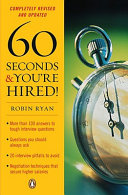

The job search process is often daunting, and the book encourages candidates to view interviews as opportunities for growth. Continuous improvement through practice is essential for building confidence and refining interview skills. The author suggests conducting mock interviews, seeking feedback, and learning from each experience. By adopting a mindset of continuous learning, candidates can enhance their performance and increase their chances of success in future interviews.
Continue readingIn the job market, first impressions are crucial. Within the first 60 seconds of an interview, hiring managers form opinions about candidates. This idea emphasizes the importance of body language, attire, and initial greetings. Candidates should be aware of how they present themselves, as this can significantly influence the interview outcome. The book provides strategies for making a positive first impression, such as maintaining eye contact, offering a firm handshake, and dressing appropriately for the job. Understanding the psychology behind first impressions can help candidates position themselves favorably.
Continue readingAn elevator pitch is a succinct and persuasive speech that outlines who you are, what you do, and what you can offer. The book stresses that candidates should be able to deliver their elevator pitch within 60 seconds. This pitch should highlight key accomplishments, relevant skills, and career goals, tailored to the specific job. The ability to articulate one's value proposition quickly is critical in a competitive job market. The author provides examples and templates to help readers create their own pitches, ensuring they can communicate effectively in various situations.
Continue readingThe STAR method (Situation, Task, Action, Result) is a structured approach to answering behavioral interview questions. The book illustrates how candidates can use this technique to provide clear and concise responses that demonstrate their problem-solving abilities and achievements. By framing answers within this structure, candidates can effectively showcase their experiences and skills. The author encourages practice with this method, as it helps candidates feel more confident and prepared during interviews.
Continue readingUnderstanding the company you're applying to is vital for a successful interview. The book highlights the importance of researching the organization's culture, values, and recent developments. This knowledge allows candidates to tailor their responses to align with the company's goals and demonstrate genuine interest. The author provides tips on how to gather information from various sources, including the company's website, social media, and news articles. Being well-informed can set candidates apart and show that they are proactive and engaged.
Continue readingAt the end of an interview, candidates are typically given the opportunity to ask questions. The book emphasizes that asking insightful questions can leave a lasting impression on interviewers. Thoughtful questions can demonstrate curiosity and engagement, as well as provide candidates with valuable information about the role and company. The author suggests preparing a list of questions in advance and tailoring them based on the interview conversation. This approach not only helps candidates gather important information but also reinforces their interest in the position.
Continue readingFollowing up after an interview is a critical step in the job search process. The book discusses the importance of sending a thank-you note or email to express appreciation for the opportunity and reiterate interest in the position. This gesture can help candidates stand out and reinforce their commitment to the role. The author provides guidelines on how to craft effective follow-up messages, including timing, content, and tone. A well-timed follow-up can enhance a candidate's chances of being remembered positively by the hiring team.
Continue reading